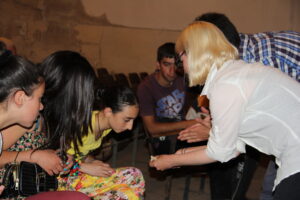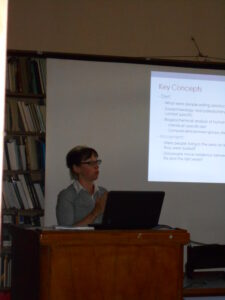Engaged Anthropology Grant: Maureen E. Marshall

Maureen E. Marshall received her Ph.D. in Anthropology from the University of Chicago. In 2010 she received a Dissertation Fieldwork Grant to aid research on ‘Political Subjects: Movement, Mobility, and Emplacement in Late Bronze Age (1500-1250 BC) Societies in Armenia,’ supervised by Dr. Adam Thomas Smith. Last year, she received the Engaged Anthropology Grant, which allowed her to make a return trip to Armenia in order to engage with the host community who supported her original research.
When I returned to Armenia this summer for the first time in several years, I was confident that I would meet two out of my three goals. I had proposed a project titled, “Articulating Ancient Lives,” in which I would engage academic and public communities in Armenia through an academic presentation of the results of my research at the Institute for Archaeology and Ethnography, collaborating on co-authored articles with colleagues who contributed information to the original dissertation research project, and a public workshop in the town Tsaghkahovit. It was this last component of community engagement that worried me.
Despite my trepidation, the public talk turned out to be productive and engaging for both local residents and archaeologists. Over the past 16 years, local residents from this community have been indispensable participants in archaeological investigations at the nearby site of Tsaghkahovit, a site in central Armenia’s Aragatsotn province that hosted substantial human occupation in the Late Bronze and Late Iron ages (ca. 1500-1150 BC and 640-350 BC).With the organizational assistance of the mayor of Tsaghkahovit and the assistance of an Armenian translator, the public event was held in the community center at the Tsaghkahovit on July 25th, 2014. I was joined by two other members of Project ArAGATS, Dr. Lori Khatchadourian and Dr. Ian Lindsay, who also discussed the findings of their research at Tsaghkahovit. My goals were to share what we have learned about the ancient Late Bronze Age (LBA) community that once occupied their neighborhoods and in doing so to connect the past and present for community members by comparing their own experiences to the diets, diseases, and violence that people lived through in the past. With this goal in mind, I decided to conduct a “hands on” learning experience by showing examples of arthritis, healed broken bones, cavities etc. on an individual excavated from the Late Bronze Age Tsaghkahovit cemetery. Given the possible sensitivity to human remains, I was unsure how participants would react. Yet, as soon as I started unpacking the bones and laying them out in anatomical position people walked up to the table and examined what I was doing. It wasn’t long before the table was completely surrounded by young students asking questions and taking photos of each skeletal feature that I pointed out and avidly asking questions about everything from pathologies to determining the sex of a skeleton to preservation. In the formal presentation, I briefly discussed the human skeleton, bone chemistry, and what we can learn about societies from ancient human remains. While people related to the topics of dental disease and aging, how the individual was interred and traumatic injuries generated the most interest and prompted a discussion of how we might distinguish injuries sustained in an activity like boxing from those related to warfare or raiding. The workshop not only met, but exceeded my expectations, opening up a dialogue with the students about how they could get involved in our archaeological projects, while giving a teacher the opportunity to relate his own experience discouraging students from digging into the tombs themselves. The public forum thus gave community members a chance to communicate to the archaeologists some of their own feelings and interests in the ancient sites that neighbor their homes. We hope to build on this model with public outreach activities such as a community day and continuing discussions of how our research can contribute to local development and archaeological tourism.

The second part of the project consisted of an academic presentation coordinated by the Institute of Archaeology and Ethnography (IAE) in Yerevan and the American Research Institute of the South Caucasus (ARISC) on July 29th, 2014 at the IAE. I presented the results of my Wenner Gren funded project on the biogeochemical analysis of human remains from Late Bronze Age and Iron I Period tombs excavated in the Tsaghkahovit Plain, Shirak Plain, and Sevan Basin in Armenia. The results of these analyses were used to reconstruct diet, specifically to distinguish types of plants (C3 versus C4 photosynthetic pathway) and animals (terrestrial versus marine) consumed, sources of the energy and protein portions of the diet, and tendencies toward herbivore or carnivore diets. In addition, movement was assessed based on the analysis of δ18O and 87Sr/86Sr. In the presentation I gave examples of how I have combined this information on movement and diet was combined with other osteological analyses such as disease, age, and sex to build rich biographies of individuals living in the LBA. While the issues of diet and mobility are central to LBA archaeology, the majority of comments that I received from the audience had to do with the potential of the bioarchaeological approach and biogeochemical analysis in the archaeology of Armenia. The director of the Institute pointed out that this type of research on human remains had never been conducted in Armenia before and that he hoped not only that such research would continue but also stressed the need for Armenian students to learn from bioarchaeologists such as myself.
Through this combined engagement with both academic and public communities in Armenia, I was able to share the results of the first biogeochemical archaeological research in Armenia with the people who made the first stages of research possible and foster international collaborative relationships. By demonstrating what can be learned about how people lived in the past from the bioarchaeological approach, I believe that an important first step was taken in creating an engaged community who is informed about and interested in human remains and their role in anthropological research.